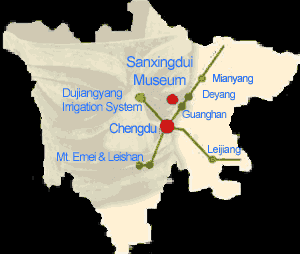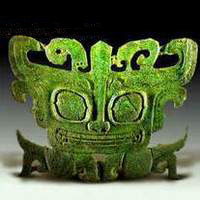
Location of Sanxingdui in Sichuan
Contemporaries of the Shang
The Sanxingdui-site in Sichuan
Close to Chengdu, in Sichuan Province, an archaeological excavation conducted in 1986 helped to rescue objects from two sacrificial pits created by people of the Bronze age who were contemporaries of the Shang, but did not leave any written records. The pits contained elephant tusks and small as well as huge bronze masks, many of them damaged (supposedly on purpose) before buried in the pit.

Location of Sanxingdui in Sichuan
This culture soon came to be named Sanxingdui ('Three-Star-Mounds';
the name refers to three remnants of a man-made wall) after the village with
the excavation location ca. 40 km northeast of modern Chengdu in modern Guanghan
county.
As early as 1929 a pit filled with 300-400 jade and stone artifacts had been
found in the area. This pit indicated that the location may have been a settlement
of major importance in neolithic times but it was not until the civil war and
World War II were over and the People's Republic of China had been founded that
in 1951 a field survey could be conducted. The survey showed that artifacts
were distributed over a large territory. But only in the summer of 1986 workers
who were digging clay to make bricks in the local brick factory accidently found
the two pits filled with sacrificial objects that came to pose many riddles
- some of which remain unsolved to this day- to archaeologists and historians.
Both pits had been dug by the Bronze age community specifially for the burial
of the objects. Pit 1 was ca. 1.5 m deep, 3 x 4 m at the bottom, and 3.5 by
4.5 m at the top and was filled in layers with more than 400 objects:
Bronze artifacts: 200 bronze vessels, 'human' head shaped masks, 44 dagger-axes,
and 107 rings.
200 stone and jade objects, more than 60 tools, more than 70 blades of various
design.
4 gold items and 40 pottery vessels.
Small objects of stone, jade, and gold were deposited first, bronze heads and
vessels followes, burnt ashes and bones (of pig, sheep, ram, cattle, and buffalo);
after that elephant tusks, in the end pottery vessels and large stone and jade
blades.
The contents of pit 2 were even richer: 67 elephant tusks, 4600 cowrie shells, and 1300 artifacts, some of them small, some monumental including a lifesize human bronze figue on a pedestal and a 4 m high bronze tree. Among the more than 40 bronze heads were six that were covered with gold foil; twenty large bronze masks - some of 'supernatural beings ?' were found which may have been used in ceremonies. Yet the use of these masks could not be defined until today just as the reason for the burial of theses objects is still not clear at all. Many objects have been burned and broken before the burial, possibly to destroy their functionality in this world and to facilitate their transformation/passage to function in a supernatural arena. The human heads and human head-shaped masks have been interpreted as a replacement for human sacrifices.


Human head-shaped bronzes that may have been mounted on a wooden pole;
the right mask is partly covered with gold foil

Sanxingdui mask

Mask of a supernatural being
If we compare the discoveries of Anyang and Sanxingdui there
are striking differences beyond the types of artifacts:
The use of the sacrificial vessels found in Anyang is clear. They have been
found in the context of tombs and were used for wine and food offerings.
In the Sanxingdui sacrifice pits, there were only vases of the zun and lei-types (which were not produced in Sanxingdui but most likely have been imported from the central plain [zhongyuan]-area) used for storage; they contained cowrieshells, jades, and small objects. No masks of the Sanxingdui kind have been found in Anyang.
In addition to pit 1 and 2, five further pits have been found in the meantime which contained stone and jade objects like large disks, rings, forked blades as well as raw material, half-finished objects and even debris from the production process, as opposed to finished artifacts.
[For further information see Robert Bagley (ed.), Ancient Sichuan. Treasures from a Lost Civilization. Seattle, Princeton: Seattle Art Museum, Princeton University Press 2001.]